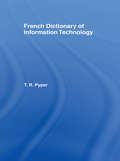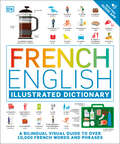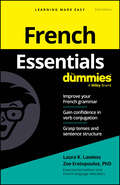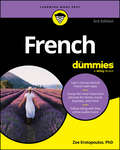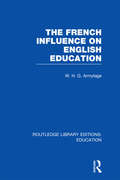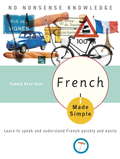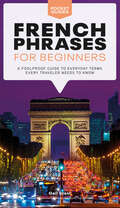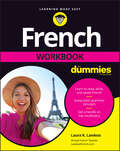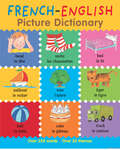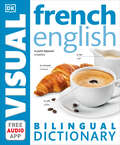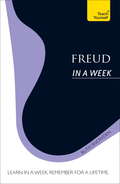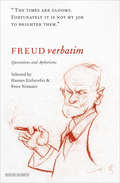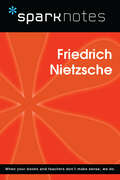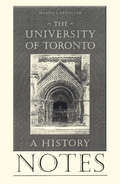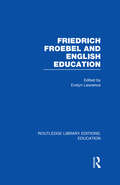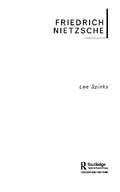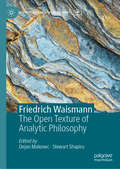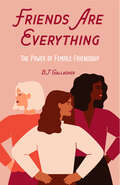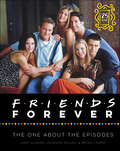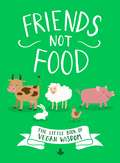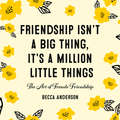- Table View
- List View
French Dictionary of Information Technology: French-English, English-French
by Terry PyperGiven the recent advances in telecommunications and the fact that the French lead the field in many aspects of information technology, this will be a valuable tool for students, translators and interpreters. The author has himself worked for a number of years as a technical translator and the dictionary reflects his knowledge and practical experience. 30,000 entries in each language cover terminology used in telecommunications, electronics and computer science, and developments in related disciplines such as the design and manufacture of printed circuits and components, installation, testing, maintenance and software programming.
French English Illustrated Dictionary: A Bilingual Visual Guide to Over 10,000 French Words and Phrases
by DKOrganized by subject and with an accompanying audio app, this is the essential reference for all French language learners.Learn more than 10,000 of the most useful words and phrases in French with this beautifully illustrated dictionary for French-language students. Building on the success of the English for Everyone course books and the Bilingual Visual Dictionary series, French/English Illustrated Dictionary uses crystal-clear illustrations to show the meaning of over 10,000 words of French vocabulary. The words are shown in a visual context in themed sections covering practical or everyday topics (such as shopping, food, or study), providing learners with all the vocabulary they need for work, travel, and leisure.Learning French vocabulary is even easier with this visually stunning dictionary.
French Essentials For Dummies
by Laura K. Lawless Zoe ErotopoulosGet right to the good stuff with this easy-to-follow guide to French fundamentals French Essentials For Dummies, 2nd Edition walks you through the core concepts of French so you can apply right away and start communicating effectively. From conjugating verbs to understanding tenses, this easy-to-read guide skips past the fluff and dives deep into the basics you need to improve your French and succeed on a French class exam and more. This guide helps you figure out the right articles, adjectives, and pronouns you need to use in different situations. Plus, you'll also get expert advice on when to use the past tense, the imperfect, and how to express the future. Inside: Make adjectives agree, understand the different parts of French speech, and select the right preposition Correctly ask and answer yes or no questions and participate in simple conversations Use important verb distinctions, correctly pronounce French words, and deploy proper grammar Perfect for everyone taking a French class, undertaking solo French study, or anyone looking for a handy, practical supplement to improve their understanding of the language, French Essentials For Dummies, 2nd Edition is a hands-on reference packed with the tools, tips, and strategies you need to speak French.
French For Dummies
by Zoe ErotopoulosLearn to speak French with confidence—the easy way French For Dummies gives you an immersive look into the foundations of the French language. The trusted Dummies language learning method is quick and practical, so you'll know what to say and do when traveling to a French-speaking country or interacting with French speakers in your community. You'll learn the basics of French grammar and pronunciation, and then you'll explore common phrases you'll need in everyday situations. Total beginners and those with some prior knowledge of français can get ready to study, work, or travel abroad—or integrate French into your everyday life—fast and easy. Make small talk, understand common expressions, navigate business settings, ask for directions, go to the doctor, and beyond, with this essential resource. Learn how the French language works—grammar, pronunciation, and important constructions Build your vocabulary and learn common expressions you’ll hear while abroad Brush up your conversation skills with authentic dialogues, plus follow along with online audio Get practice reading, writing, and speaking French, so you’re ready to communicate effectively With French For Dummies, students, travelers, and business professionals can gain the confidence to converse in French.
French Influence on English Education (Routledge Library Editions: Education)
by W H ArmytageIn this volume the author discusses the influence of France from the Norman invasion to the late 1960s. French thought and ideas are examined and more tangible evidence is also given of the widespread and often unnoticed influence that France has exerted on English education.
French Made Simple: Learn to speak and understand French quickly and easily (Made Simple)
by Pamela Rose HazeFrench Made Simple will help you learn to speak French quickly and easily! An invaluable introduction to one of the most studied languages, French Made Simple is ideal for students, business professionals, and tourists alike. Teaching the basics of grammar, vocabulary, and culture, it guides you step-by-step through the process of learning and conversing quickly. Refreshingly easy to understand, French Made Simple includes: • Grammar basics • Modern vocabulary • Helpful verb chart • French-English dictionary • Reading exercises • Economic information • Common expressions • Review quizzes • Complete answer key
French Philosophy of Technology: Classical Readings And Contemporary Approaches (Philosophy Of Engineering And Technology Ser. #29)
by Sacha Loeve Xavier Guchet Bernadette Bensaude VincentOffering an overall insight into the French tradition of philosophy of technology, this volume is meant to make French-speaking contributions more accessible to the international philosophical community. The first section, “Negotiating a Cultural Heritage,” presents a number of leading 20th century philosophical figures (from Bergson and Canguilhem to Simondon, Dagognet or Ellul) and intellectual movements (from Personalism to French Cybernetics and political ecology) that help shape philosophy of technology in the Francophone area, and feed into contemporary debates (ecology of technology, politics of technology, game studies). The second section, “Coining and Reconfiguring Technoscience,” traces the genealogy of this controversial concept and discusses its meanings and relevance. A third section, “Revisiting Anthropological Categories,” focuses on the relationships of technology with the natural and the human worlds from various perspectives that include anthropotechnology, Anthropocene, technological and vital norms and temporalities. The final section, “Innovating in Ethics, Design and Aesthetics,” brings together contributions that draw on various French traditions to afford fresh insights on ethics of technology, philosophy of design, techno-aesthetics and digital studies. The contributions in this volume are vivid and rich in original approaches that can spur exchanges and debates with other philosophical traditions.
French Phrases for Beginners: A Foolproof Guide to Everyday Terms Every Traveler Needs to Know (Pocket Guides)
by Gail SteinSound like a native in no time!You've decided to cross off a bucket list item by visiting France or one of the many countries where French is spoken—but you don't know much more than a few words en français. With everything you need to pack for your trip, you won't want to lug around an English to French dictionary. All you really need is this French Phrases for Beginners pocket guide.This handy book includes these features: • Everyday terms to use when traveling, shopping, and eating out • Conversational phrases for discussing the weather, sports, and family • Popular idioms to help you sound (almost) like a native French speaker • Pronunciation keys for nearly every phrase discussedWhether you need to know what time the train leaves, how to ask for an ambulance, or the all-important question of where's the bathroom, French Phrases for Beginners is your go-to companion for ensuring you enjoy your visit to France or anywhere else where French is spoken.
French Workbook For Dummies
by Laura K. LawlessWrite, read, work, and play—en Français French Workbook For Dummies is the perfect starting place for beginners who want to learn French. Packed with foundational grammar and integrated vocab, this hands-on book will set you on your way to picking up a new language. You&’ll find valuable practice lessons and exercises throughout that help you learn key vocabulary and phrases, writing in French, and understanding the fifth most commonly spoken language worldwide. Start with the very basics of the French language and work your way through important grammar and vocabulary Follow lessons at your own pace and complete practice exercises to hone your skill Learn using the Dummies method—based on evidence about how people learn best Gain the confidence to speak French in the workplace and while you travelFor anyone learning French for use at home, at the office, or on the go, French Workbook For Dummies is a vital asset.
French-English Picture Dictionary (First Bilingual Picture Dictionaries)
by Louise Millar Susan Martineau Catherine BruzzoneAre there kids in your life who want to learn French? This is the perfect dictionary! Included are pages filled with bright and colorful pictures and bilingual labels to help teach French words to English speaking children.Parents, teachers, and gift givers will find:350 illustrations of familiar objectsPictures labeled with the English word followed by its French equivalentPhonetic spellings of French wordsWords grouped by themesThis dictionary is a fun way for young English-speaking children to build a basic vocabulary in French. It's never too soon to start teaching boys and girls a second language!
French–English Bilingual Visual Dictionary (DK Bilingual Visual Dictionaries)
by DKThis is the perfect pocket reference for those learning French, and you&’ll want to make sure it's packed when you next go on your travels.With over 6,000 fully illustrated terms arranged by theme, getting to grips with the French language has never been easier. Whether you&’re traveling for business or leisure, buying food or train tickets, discussing work or tourism, you&’ll gain confidence in your new language skills with a bilingual visual dictionary by your side. Photographs and comprehensive indexes combine to make finding the word you need a quick and easy task. The French-English Bilingual Visual Dictionary also features an easy-to-use free audio app (available on the App Store and Google Play) enabling you to hear terms spoken out loud. Learn and retain all the key phrases and words you need to know and perfect your pronunciation.DK&’s bilingual visual dictionaries are truly bilingual; every section is written side by side in both languages – right from the contents to the index – meaning that this dictionary is easy to use for native speakers and learners alike. Whether you&’re studying a new language in the classroom or practicing on your travels, choose a DK bilingual visual dictionary to be part of your essential kit.
Freud In A Week: Teach Yourself
by Ruth SnowdenLearn in a week, remember for a lifetime!In just one week, this accessible book will give you knowledge to last forever. End of chapter summaries and multiple choice questions are all designed to help you test your knowledge and gain confidence. So whether you are a student or you simply want to widen your knowledge, you will find this seven-day course a very memorable introduction.Sunday: Learn who Freud was and what he didMonday: Explore Freud's early work and the beginnings of his psychoanalytical ideasTuesday: Discover Freud's views on the interpretation of deams and on the importance of the unconsciousWednesday: Consider Freud's often-controversial sexual theoriesThursday: Understand Freud's views on the importance of childhood, and how adult identity is formedFriday: Learn about Freud's views on civilization, religion and societySaturday: Look at how psychoanalysis has developed since Freud's time and how it is used today.
Freud In A Week: Teach Yourself
by Ruth SnowdenLearn in a week, remember for a lifetime!In just one week, this accessible book will give you knowledge to last forever. End of chapter summaries and multiple choice questions are all designed to help you test your knowledge and gain confidence. So whether you are a student or you simply want to widen your knowledge, you will find this seven-day course a very memorable introduction.Sunday: Learn who Freud was and what he didMonday: Explore Freud's early work and the beginnings of his psychoanalytical ideasTuesday: Discover Freud's views on the interpretation of deams and on the importance of the unconsciousWednesday: Consider Freud's often-controversial sexual theoriesThursday: Understand Freud's views on the importance of childhood, and how adult identity is formedFriday: Learn about Freud's views on civilization, religion and societySaturday: Look at how psychoanalysis has developed since Freud's time and how it is used today.
Freud Verbatim: Quotations and Aphorisms
by Sigmund FreudThe founder of psychoanalysis and one of the twentieth century&’s most influential thinkers, in his own words. Sigmund Freud is on the very short list of historical figures who have profoundly influenced—perhaps even revolutionized—the way we think and the way we see the world and ourselves. This book compiles quotes, maxims, observations, and witticisms from the founder of psychoanalysis and the popularizer of such terms as ego, superego, and id. Covering subjects ranging from politics and religion to love and sex, this collection assembles passages from Freud&’s major works, as well as making use of personal letters to his friends and family. Organized into ten thematic chapters, this thought-provoking compilation provides a representative look into all of Freud&’s work.
Freud: Dictionary of Psychoanalysis
by Nandor Fodor Frank GaynorThis book comprises Freud's dictionary on Psychoanalysis and would be a useful tool for all interested in Psychology.
Friederich Nietzsche (SparkNotes Philosophy Guide)
by SparkNotesFriederich Nietzsche (SparkNotes Philosophy Guide) Making the reading experience fun! SparkNotes Philosophy Guides are one-stop guides to the great works of philosophy–masterpieces that stand at the foundations of Western thought. Inside each Philosophy Guide you&’ll find insightful overviews of great philosophical works of the Western world.
Friedland: A History
by Martin FriedlandTwo histories of the University of Toronto have been published, one in 1906 and one in 1927. Since the latter volume appeared, no comprehensive history of the University has been published. Given the size of the University and the complexity of the task, this is not entirely surprising. But, after sixty-six years, this gap in the intellectual history of Canada has been filled, and we are delighted to announce publication, in March of 2002, of Martin Friedland's new history of one of Canada's most important educational and cultural institutions.The author of several books on legal history, Professor Friedland brings to this task an accomplished eye and ear and a status as a long time member of the University community. Professor Friedland's text is accompanied by over 200 maps, drawings and photographs.Published to coincide with the University's 175th anniversary, The University of Toronto: A History tells the story of the university in the context of the history of the nation of which it is a part, weaving the stories of the people who have been a part of this institution - people who make up a who's who in the history of Canada.Anyone who attended the University or who is interested in the growth of Canada's intellectual heritage will enjoy this compelling and magisterial history.
Friedrich Froebel and English Education (Routledge Library Editions: Education)
by Evelyn LawrenceThis collection of essays describes Froebel’s life and the history of his influence on the education of young children in Britain. It also traces the religious roots of his philosophy and discusses his psychological and educational principles in the light of developments in these fields since his day.
Friedrich Nietzsche (Routledge Critical Thinkers)
by Lee SpinksIt is difficult to imagine a world without common sense, the distinction between truth and falsehood, the belief in some form of morality or an agreement that we are all human. But Friedrich Nietzsche did imagine such a world, and his work has become a crucial point of departure for contemporary critical theory and debate. This volume introduces this key thinker to students of literary and cultural studies, offering a lucid account of Nietzsche's thought on:* anti-humanism* good and evil* the Overman* nihilism* the Will to Power.Lee Spinks prepares readers for their first encounter with Nietzsche's most influential texts, enabling them to begin to apply his thought in studies of literature, art and contemporary culture.
Friedrich Waismann: The Open Texture of Analytic Philosophy (History of Analytic Philosophy)
by Stewart Shapiro Dejan MakovecThis edited collection covers Friedrich Waismann's most influential contributions to twentieth-century philosophy of language: his concepts of open texture and language strata, his early criticism of verificationism and the analytic-synthetic distinction, as well as their significance for experimental and legal philosophy. In addition, Waismann's original papers in ethics, metaphysics, epistemology and the philosophy of mathematics are here evaluated. They introduce Waismann's theory of action along with his groundbreaking work on fiction, proper names and Kafka's Trial. Waismann is known as the voice of Ludwig Wittgenstein in the Vienna Circle. At the same time we find in his works a determined critic of logical positivism and ordinary language philosophy, who anticipated much later developments in the analytic tradition and devised his very own vision for its future.
Friends Are Everything: The Power of Female Friendship
by BJ GallagherAppreciate your True Friends with Friendship Quotes and Stories“BJ Gallagher ... motivates and teaches with empathy, understanding, and more than a little humor.” —Debba Haupert, of the Girlfriendology PodcastTrue friends are hard to find and even harder to describe. But with real life stories, friendship quotes, inspirational quotes, and anecdotes about the ups and downs and ins and outs of friendships, Friends are Everything has everything you ever need for friendship empowerment.Beautiful friendships of all shapes and sizes. To bestselling author B.J. Gallagher, there are so many types of friends. There are friends who tell you what you don’t want to hear, friends who help you be your best self, friends who forgive you when you hurt them, friends who respect your boundaries. There are neighbors, best friends, childhood friends, spiritual friends, friends who are family, friends who are lovers, friends at work, and the list goes on. Get ready to dive into what it really means to love a friend and what it means to be one.Inspirational quotes for your girlfriends. With more than three dozen inspiring stories from girlfriends across the country, affirmative acronyms, and female empowerment quotes, Friends are Everything is a heartfelt celebration of friendships across all generations and a perfect gift to share with your bestie.Inside Friends are Everything, find friendship quotes, inspirational quotes, and words of empowerment in heartwarming and entertaining stories such as:“Please, Help Me Stop Shooting Myself in the Foot!”“Finding Mr. Probably Right”“A Woman’s Wheels”If you enjoyed books like That's What She Said; Tell Me More; or Hey Friend, I Wrote a Book About You, then you’ll love Friends are Everything.
Friends Forever: The One About the Episodes
by Gary Susman Jeannine Dillon Bryan CairnsAn authorized episode guide of the hit-television show Friends, with an insider look at cult-favorite episodes, exclusive photos, and interviews.The beloved show Friends introduced the world to six young New Yorkers living together, falling in love, breaking up, and getting into hilarious shenanigans, which became an instant classic formula that inspired dozens of “hangout sitcoms” long after the show’s reign. But no sitcom has ever come close to the series that started it all, spawning iconic looks like “the Rachel” and timeless catchphrases like “How you doin’?” while creating a cultural sensation that catapulted the cast members to instant mega-stardom.Throughout the show’s ten- season run, viewers watched Monica, Rachel, Phoebe, Ross, Chandler, and Joey navigate their twenties and thirties with unwavering friendship, determination, and, of course, plenty of sarcasm. Friends Forever takes fans back to the set where it all began with exclusive photos of the sitcom that won four Primetime Emmy Awards, including Outstanding Comedy Series, eleven People’s Choice Awards, and a Golden Globe for Jennifer Aniston for Best Lead Actress in a Television Series. This fully illustrated episode guide will treat readers to nostalgic flashbacks of the top one hundred episodes and sneak peeks of how popularly referenced lines from the show came to be. Friends Forever also boasts new interviews with show creators David Crane and Marta Kauffman on how the show got its start and set designer John Shaffner who reveals his inspirations behind the iconic looks behind Monica’s and Rachel’s apartment and Central Perk.It’s no wonder why Friends is often called one of the best sitcoms of all time.
Friends Not Food: The Little Book of Vegan Wisdom
by AnonymousChickens, Cows, Ducks, Sheep, Pigs, Rabbits, Trout, Salmon, Prawns, Lobsters - all of the animal kingdom - are not here for us to eat, we should be looking after them.Friends Not Food is a celebration of our relationship with our animal friends and is packed with vegan sayings as well as facts about both those animals and the industries that prey on them.The perfect gift for anyone who loves animals!And whilst you #StayHome, don't miss these other great titles from Sphere Books: ** Distract Yourself: 101 Positive Things to Do and Learn Whilst You Stay Home ** ** The Bumper Book of Would You Rather? Over 350 hilarious hypothetical questions for ages 6 to 106 **** Home Sweet Home: The Little Book of Natural Cleaning **** Shelf Respect: A Book Lovers' Guide to Curating Book Shelves at Home **
Friends Not Food: The Little Book of Vegan Wisdom
by AnonymousChickens, Cows, Ducks, Sheep, Pigs, Rabbits, Trout, Salmon, Prawns, Lobsters - all of the animal kingdom - are not here for us to eat, we should be looking after them.Friends Not Food is a celebration of our relationship with our animal friends and is packed with vegan sayings as well as facts about both those animals and the industries that prey on them.The perfect gift for anyone who loves animals!And whilst you #StayHome, don't miss these other great titles from Sphere Books: ** Distract Yourself: 101 Positive Things to Do and Learn Whilst You Stay Home **** The Bumper Book of Would You Rather? Over 350 hilarious hypothetical questions for ages 6 to 106 **** Home Sweet Home: The Little Book of Natural Cleaning **** Shelf Respect: A Book Lovers' Guide to Curating Book Shelves at Home **
Friendship Isn't a Big Thing, It's a Million Little Things: The Art of Female Friendship (Becca's Self-care Ser.)
by Javier MoroFrom the author of The Book of Awesome Women, a celebration of female friendships through empowering quotes from extraordinary women.Whether the friendship is decades old or just beginning, we share a unique relationship with women, a connection wholly different even from what we share with husbands or boyfriends.Be inspired by strong female friendships. Celebrate the bonds you’ve built with the wonderful women in your life. The bond shared among girlfriends is like no other. They foster the feminist practice of women supporting and enabling other women. Bestselling author and blogger Becca Anderson has long been moved by the inspirational quotes and stories of groundbreaking women, and is now sharing some of that female empowerment with us.Fill your heart with gratitude for your soul sisters. We know how much we love our friends, but do they know? This book reminds us just how valuable our bonds with our gal pals are. To those who answer the phone at four a.m. and drop everything to help a girl out, to the ones who are there for both the tearful wine nights and the champagne-worthy celebrations. As Becca Anderson says, “Our friends are some of the great loves of our lives. Mine have seen me through tough times and we have so much shared joy. My life advice is simple: make friends and treasure them.”By reading Friendship Isn’t a Big Thing, It’s a Million Little Things, you will find:Renewed value in the friendships you share with womenInspiration for growing in those relationships and further supporting your friendsReasons to celebrate the unique love you find in female friendship
